AAC in the High School Classroom: Where Core Vocabulary Meets Life Skills
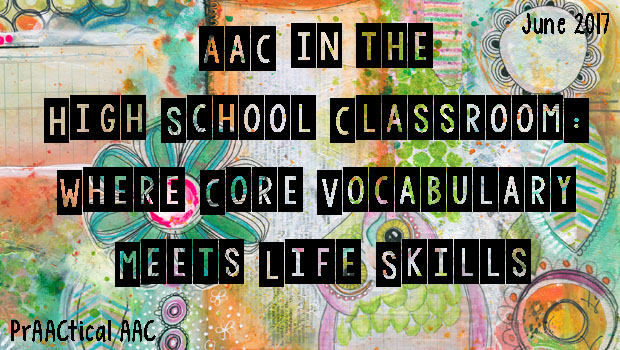
Today, guest blogger Sarah Mueller, a special education teacher in Rochester Michigan, shares her thoughts on supporting core vocabulary learning while working on functional life skills. Sarah teaches high school students with intellectual and developmental disabilities and strives to embed language and communication throughout her students’ entire school experience. Sarah helps her students become strong self-advocates as they prepare for adult life. Marlene Cummings, Sarah’s colleague and mentor, introduces the post.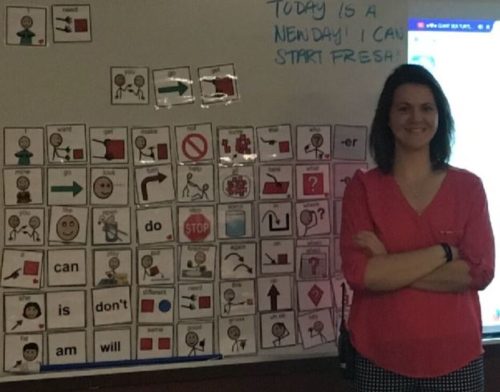
::::::::::::::::::::::::::::::::::::::::::::::::::::::::::::::::::::::::::::::::::::::
I (Marlene Cummings) had the pleasure of meeting Sarah 2 years ago as a new teacher in one of my districts. She immediately engaged in our county level professional learning opportunities in AAC and Literacy. The AAC focus presented strategies to support AAC and language learning including: core vocabulary, aided language input, vocabulary instruction and opportunities. The literacy focus was designed to create and implement a comprehensive literacy program taught by Drs. Karen Erickson and David Koppenhaver.
The outcome: an interactive, engaging learning environment where language and literacy are combined with a culture of communicative expectation. As Sarah embraced this new content a question began to form: who is already doing this and what does it look like? Let’s see what she discovered.
::::::::::::::::::::::::::::::::::::::::::::::::::::::::::::::::::::::::::::::::::::::::::::::::
Don’t Forget About Us!
As a high school special education teacher for students with intellectual and developmental disabilities, I began to find that professional development examples of literacy and language tend to focus on elementary age students. I would often ask myself, “But what does this look like in high school?” So, I sought out to answer my own question exploring, experimenting, and implementing literacy instruction and core vocabulary. As I delved deeper, several challenges and barriers emerged. I saw students who:
- Came to me with different experiences related to their language and communication abilities and experiences
- Only demonstrated the communicative function of requesting
- “Lived in the fringe”, using predominantly nouns
- Had a limited set of core words, lacking a robust language system
- Were still unsure how to communicate using visibly represented language, with little prior exposure to aided language input
- Seldom generated novel phrases spontaneously
That’s a lot of challenges to tackle. Now to decide where to start! My next question: how do I do this systematically with such a wide range of students at different language and literacy levels? I wanted to develop a universal system for instruction with communication and language available throughout.
Enter…the core! It has rocked my world and that of my student’s. I began with 32 core words and quickly transitioned to 48 with morphological markers and expanded fringe to provide my students with an even more robust vocabulary. With my large core board in the front of my class, and projected on my interactive whiteboard, low-tech core on every student desk, and on staff key chains, I embarked on explicitly teaching vocabulary, modeling language with aided language input, and using core during instruction of content. 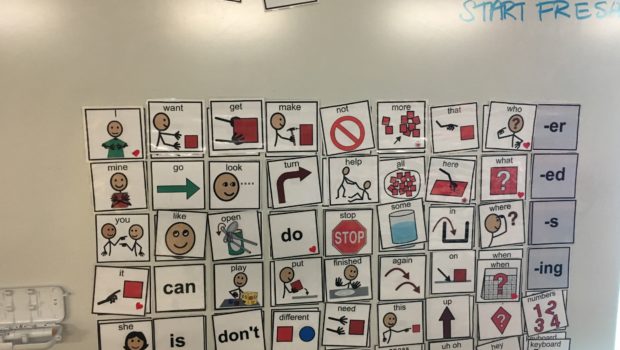
“But, I need to prepare my students for adult life. What about functional tasks?”
Often when working with older students, teachers are required or encouraged to consider this question. I know I had to! Guess what? You can still instruct with core words within a functional instructional activity that has structure but is still fluid for commenting, requesting, and social interactions.
Again I ask, “What does it look like?” Let’s explore a cooking lesson. The purpose of cooking activities are to generalize vocabulary and communication phrases (that I often have explicitly taught during literacy) in a way that is meaningful, engaging, fun, and provides social connections for my students. We cook weekly. Weekly! May seem like a lot, yet I have found it to be powerful each and every week as it’s a prime opportunity for repetition with variety. 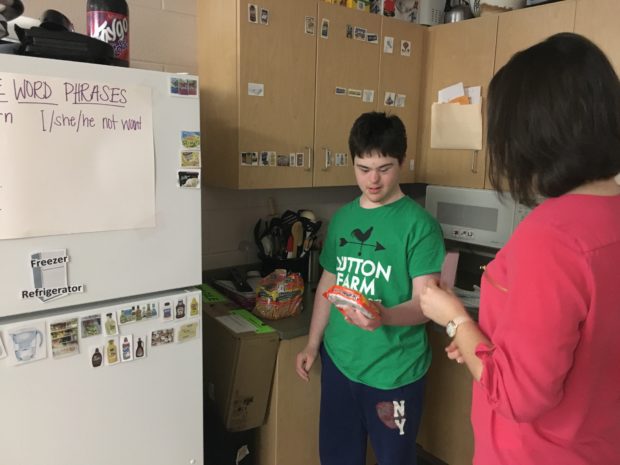
When I am preparing for cooking, I first lesson plan. Think about the core word phrases that can be used or need to focus on and the function (commenting, directive, question, etc.) For example, you may want your students to work on saying:
- I go get (insert ingredient fringe word)
- I want some
Then be strategic! What are you going to do and when? I choose to do cooking during times when I have lots of paraprofessionals to have additional support and/or peer mentors. At times, students from another special education classroom join us as additional communication partners.
Next, get ready! Set up the environment. Where is the core in your room? Is it easily accessible to model your target phrase(s)? Also, you want to be intentional with your use of fringe. You will never be able to program every student’s device every single cooking lesson with the items they will encounter. Instead, use visuals of the items, have pictures of cooking utensils and food on cupboards, or use the actual ingredient as the fringe. Students will then have to say, “I go get that” (pointing to the ingredient on the recipe, to the visual, or the actual item to be used).
Time to cook! As you go through your lesson, you are modeling your target core phase and function allowing for teachable communication moments. I’ve had a student struggle to reach an item or find an item in the cupboard. You better believe I stood and waited until they asked for help with their communication system. I even had a student drop an entire hot bowl of prepared oatmeal on my carpeted classroom! I could have jumped in to stop my student to “save” her from the situation, but what would that have taught her? It opened the door for even more conversations. So, allow for challenges and sometimes sabotage to have your students problem solve.
As your students complete the recipe and are enjoying their yummy food, begin to evaluate. Was it successful? Have your students complete a recipe review to receive feedback from them. Things I consider:
- Did ALL my students communicate?
- Was the desired function demonstrated?
- Where could I have stepped back to increase independence?
Taking the time to review and revise will truly make the next opportunity more powerful.
Remember to have fun! Sometimes cooking is seamless and other times it’s a hot mess! Either way you are providing an experience for your students to engage in communication that will help them to continue to expand and build language.
I can’t wait to hear your stories about core vocabulary for older students. We will no longer be forgotten.
You can see Sarah and her students in AACtion in the video below.
Filed under: Featured Posts, PrAACtical Thinking
Tagged With: classroom, core vocabulary, education, high school, teacher
This post was written by Carole Zangari
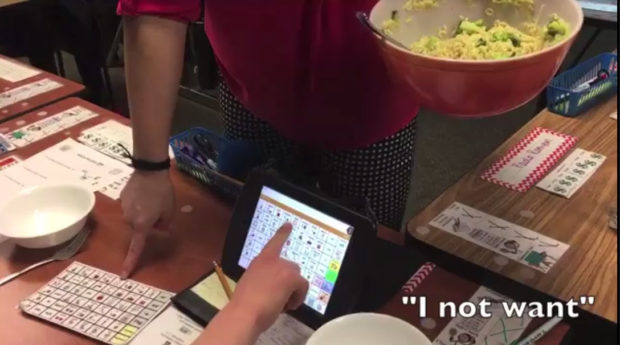

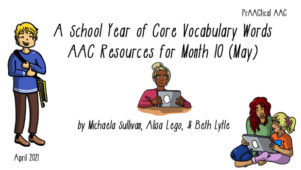
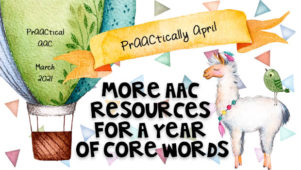
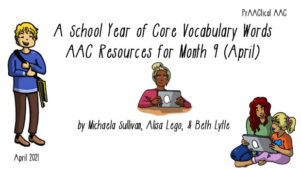
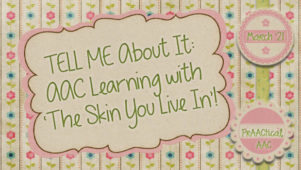
20 Comments
Thanks for the real world examples I can share with our teachers!
Awesome! Loved this post! Can someone provide a link to Sarah’s blog please?
Hi Crystal,
Thank you! I don’t have a blog but it may be something I’ll have to consider starting. 🙂 -Sarah
Thank you for this post! I work in an adult transition program and am often frustrated at the lack of language materials, or even research/information, available for this group. But I discovered core vocabulary a couple years ago and it has opened up my students’ worlds – I am still struggling to get teachers to embrace it, but this is really helpful to share with them.
Sarah,
This is amazing!!! All my students I work with use AAC devices. Where did you find the enlarged Proloque2go symbols for your board? I would love to be able to create this over the summer!
Hi Lauren,
Glad you liked the post! I used symbols from SymbolStix through Unique Learning Systems. Having a large core board has been vital to my students growth in building language. A must summer project 🙂
All the best,
Sarah
Dear Sarah,
Love your work. Can you please send me the symbols too? Thanks.
Hi Elizabeth, Feel free to contact me directly and I can send you the files.
Hi Lauren,
Feel free to contact me directly and I can send you the files.
Thank you, Marlene! I send you an email.
Love this!!!
Thank you
Thank you for this post. No one is too young for core vocabulary and no one ages out from using core vocabulary. What a great lesson.
I would love a copy of the files or just a clean photo of the board. Thank you!!!
Hi Debbie,
Feel free to email me directly at smuelle03@gmail.com and I can share the files.
Thanks!
Sarah
I love the post and the video!
Just FYI for the other commenters: there is a large core word board you can print- one for poster printers and one for regular printers located here: https://saltillo.com/chatcorner
Thanks for sharing Lauren!
This is wonderful! I am working with older students now and found this so helpful!
Thanks Karen! Hope you have a great school year!
Hi, How did you get the icons on the smartboard/touchscreen so you can model it?
Hi Kate! Thanks for asking. I used Chat Editor: https://saltillo.com/products#chat-editor. I loved being able to model right from my smart board.